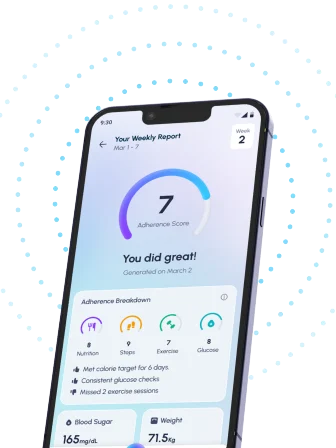Table of Contents
- Childhood Obesity: A Type 2 Diabetes Risk Factor?
- Understanding the Link Between Childhood Obesity and T2D
- Combating Childhood Obesity to Prevent Type 2 Diabetes
- Is Your Child at Risk? Recognizing Childhood Obesity Warning Signs
- Effective Strategies for Preventing Childhood Obesity and Type 2 Diabetes
- Frequently Asked Questions
- References
Are you concerned about the rising rates of childhood obesity? You should be. We’re facing a serious health crisis, and Childhood Obesity and Type 2 Diabetes: A Growing Concern is at the heart of it. This isn’t just about kids being a little overweight; we’re seeing a dramatic increase in young people developing type 2 diabetes, a disease traditionally associated with adulthood. In this blog post, we’ll explore the alarming link between childhood obesity and this devastating disease, examining the contributing factors and discussing practical steps we can take to protect our children. Let’s dive in and learn how we can make a difference.
Childhood Obesity: A Type 2 Diabetes Risk Factor?
Childhood obesity is a rapidly growing concern in Indian and tropical countries, significantly increasing the risk of developing type 2 diabetes later in life. This isn’t just a Western problem; it’s a global health crisis impacting vulnerable populations disproportionately. The alarming reality is that children are developing this typically adult-onset disease at increasingly younger ages.
Understanding the Link
The connection between childhood obesity and type 2 diabetes is complex but undeniable. Excess weight strains the pancreas, impacting its ability to produce sufficient insulin – the hormone responsible for regulating blood sugar. Consequently, high blood sugar levels become a chronic problem, leading to type 2 diabetes. Moreover, research shows a concerning hereditary element: children born to mothers with gestational diabetes are seven times more likely to develop type 2 diabetes later in life. This highlights the importance of prenatal care and healthy lifestyle choices for mothers. For a deeper understanding of this complex relationship, read more in our article, Understanding the Link Between Diabetes and Obesity.
Regional Challenges and Solutions
In many Indian and tropical countries, dietary changes driven by globalization and urbanization contribute to the rise of childhood obesity. Increased consumption of processed foods, sugary drinks, and a decrease in physical activity all play significant roles. Addressing this requires a multi-pronged approach. Promoting healthier eating habits, encouraging physical activity through initiatives in schools and communities, and increasing public awareness are crucial steps. Early detection through regular health check-ups is equally vital.
Taking Action
The future well-being of children in our region depends on our collective efforts to combat childhood obesity and its devastating consequences. Prioritizing healthy lifestyles from an early age, advocating for better nutrition education, and supporting policies that promote healthier food choices are all essential for creating a healthier future generation. Let’s work together to prevent type 2 diabetes from becoming a defining health issue for our children. It’s important to note that while obesity is a major risk factor, Which Condition is Not Usually Associated with Type 2 Diabetes? can help clarify some misconceptions about the condition.
Understanding the Link Between Childhood Obesity and T2D
Childhood obesity is a rapidly escalating health crisis in many Indian and tropical countries, significantly increasing the risk of developing type 2 diabetes (T2D) later in life. This isn’t just a correlation; there’s a strong causal link. Excess weight, particularly abdominal fat, leads to insulin resistance – the body’s inability to effectively use insulin to regulate blood sugar. This resistance is a hallmark of prediabetes, a critical stage before a full-blown T2D diagnosis.
The Growing Threat of Prediabetes
The alarming fact is that individuals with prediabetes have a significant annual risk of progressing to T2D. Research indicates a 5-10% annual risk of developing T2D in those with prediabetes. This study highlights the urgency of addressing prediabetes, especially among children in regions like India and other tropical countries where lifestyle changes and access to healthcare can be challenging. The high prevalence of sugary drinks and processed foods in these regions further exacerbates the problem. This is particularly concerning given the impact of diabetes on teenagers, as highlighted in our article, Diabetes in Teenagers: Understanding the Impact – Tap Health.
Taking Action: Prevention Strategies
Promoting healthy lifestyles from a young age is crucial. This includes encouraging regular physical activity, tailored to the cultural contexts of these regions, and emphasizing a balanced diet rich in fruits, vegetables, and whole grains. Parents and communities must play a vital role in creating supportive environments that prioritize healthy eating and active lifestyles. Early intervention and regular health check-ups are also essential for identifying and managing prediabetes, effectively reducing the transition to T2D. Early detection and management are key to preventing long-term health complications. Let’s work together to combat this growing concern and build healthier futures for our children. It’s also important to note that weight management strategies differ depending on the individual’s situation. For those with T2D who need to gain weight, consider reading our guide on how to gain weight with type 2 diabetes.
Combating Childhood Obesity to Prevent Type 2 Diabetes
Childhood obesity is a rapidly growing concern in Indian and tropical countries, significantly increasing the risk of developing type 2 diabetes. While 1.2 million children and adolescents globally live with type 1 diabetes, the alarming rise in obesity fuels a parallel surge in type 2 diabetes among young populations. This is particularly worrying in regions with limited access to healthcare and nutritious food. The consequences are severe, impacting not only physical health but also long-term quality of life.
Understanding the Link
The connection between obesity and type 2 diabetes in children is undeniable. Excess weight strains the pancreas, leading to insulin resistance – the body’s inability to effectively use insulin to regulate blood sugar. This ultimately results in high blood sugar levels, a hallmark of type 2 diabetes. Factors like unhealthy diets rich in processed foods, sugary drinks, and lack of physical activity are key contributors to this escalating problem. Furthermore, genetic predisposition and socioeconomic factors play a significant role, particularly within low-income communities in tropical regions.
Practical Steps for Prevention
Combating childhood obesity requires a multi-pronged approach. Promoting healthy eating habits, including increased consumption of fruits, vegetables, and whole grains, is crucial. Encouraging regular physical activity through active play and sports is equally important. Schools and communities need to create supportive environments that prioritize nutrition and exercise. Government initiatives focusing on food accessibility and affordability, particularly in rural areas, are essential for long-term impact. Early detection and intervention are also vital, allowing for timely management and reducing the risk of long-term complications. For more information on managing Type 2 Diabetes, read 5 Easy Lifestyle Changes to Manage Type 2 Diabetes.
Call to Action
Parents, educators, and healthcare professionals in Indian and tropical countries must actively work together to tackle this growing crisis. Let’s empower children to lead healthier lives and prevent the devastating effects of type 2 diabetes. Join the movement towards a healthier future for our children. Understanding the symptoms and causes of Type 2 Diabetes is also crucial for early intervention. Learn more by reading Type 2 Diabetes: Symptoms, Causes and Treatment – Tap Health.
Is Your Child at Risk? Recognizing Childhood Obesity Warning Signs
Childhood obesity is a significant health concern, particularly in India and other tropical countries, significantly increasing the risk of developing type 2 diabetes. A recent screening of 92,047 school children in India revealed a concerning statistic: 1,351 (1.467%) were suspected of having diabetes. This highlights the urgent need for increased awareness and proactive measures. 1.467% of children screened were suspected diabetics.
Identifying the Warning Signs
Recognizing the warning signs of childhood obesity is crucial for early intervention. Overweight children often exhibit rapid weight gain, exceeding the expected growth charts for their age and height. Look for signs like increased abdominal fat, difficulty participating in physical activities due to excess weight, and a family history of obesity or type 2 diabetes. Excessive thirst and frequent urination can also indicate underlying issues like insulin resistance, a precursor to type 2 diabetes. Dietary habits also play a key role: a diet high in processed foods, sugary drinks, and refined carbohydrates can significantly contribute to weight gain. For more information on early signs of diabetes, check out 10 Early Signs and Symptoms of Diabetes? – Tap Health.
Taking Action
In India and other tropical regions, access to nutritious food and opportunities for physical activity can be challenging, compounding the issue. Encourage healthy eating habits from a young age, focusing on fresh fruits, vegetables, and whole grains. Limit sugary drinks and processed foods. Promote regular physical activity through games, sports, and active play, tailoring activities to suit the climate and available resources. If you are concerned about your child’s weight or suspect they may have diabetes, consult a pediatrician or healthcare professional immediately. Early diagnosis and intervention are vital in preventing long-term health complications. Early detection and management are key to a healthier future for your child. Learn more about fostering healthy eating habits in children by reading How Can You Foster Healthy Eating Habits in Children?
Effective Strategies for Preventing Childhood Obesity and Type 2 Diabetes
Childhood obesity is a rapidly growing concern in India and other tropical countries, significantly increasing the risk of developing type 2 diabetes. This is a serious issue, as research indicates that up to 80% of Type 2 diabetes cases can be delayed or prevented through lifestyle changes. Making these changes early in life is crucial. This means focusing on prevention in children, before the onset of serious health issues.
Promoting Healthy Eating Habits
Indian diets, while diverse, often include high amounts of processed foods, sugar, and refined carbohydrates. Promoting a balanced diet rich in fruits, vegetables, and whole grains is critical. Encourage families to cook more meals at home, using fresh, seasonal ingredients readily available in local markets. Limit sugary drinks and snacks, replacing them with healthier alternatives like fresh fruit juices (diluted) and nuts. Educating parents about appropriate portion sizes for children is also key.
Encouraging Physical Activity
Sedentary lifestyles are a major contributor to childhood obesity. In many tropical regions, the heat can be a barrier to outdoor activity, but it’s important to find creative solutions. Encourage activities like dancing, indoor games, and swimming, particularly in the cooler parts of the day. Schools can play a vital role by integrating physical education into the daily curriculum and promoting active breaks. Regular physical activity is vital for maintaining a healthy weight and reducing the risk of type 2 diabetes. For more information on managing long-term complications, see our guide: How to Prevent Long-Term Complications of Diabetes: Easy Tips.
Community-Based Interventions
Addressing childhood obesity requires a multi-pronged approach. Community-based programs focusing on nutrition education, physical activity promotion, and access to healthy food options are essential. These initiatives should be tailored to the specific cultural and environmental context of each region, ensuring they are both accessible and effective. This may involve partnering with local leaders and organizations to maximize impact and sustainability. Lifestyle changes are key to prevention. While this article focuses on preventing type 2 diabetes, parents of children with Type 1 diabetes may find valuable insights in Tips for Parents of Kids with Type 1 Diabetes: Complete Guide.
By implementing these strategies, we can significantly reduce the burden of childhood obesity and type 2 diabetes in India and other tropical countries, ensuring a healthier future for generations to come.
Frequently Asked Questions on Childhood Obesity & Type 2 Diabetes
Q1. What is the connection between childhood obesity and type 2 diabetes?
Childhood obesity significantly increases the risk of type 2 diabetes. Excess weight leads to insulin resistance, causing high blood sugar levels, a hallmark of type 2 diabetes.
Q2. What are the main causes of childhood obesity?
A combination of genetic predisposition and lifestyle factors contributes to childhood obesity. These factors include diets high in processed foods and sugary drinks, coupled with a lack of physical activity.
Q3. How can childhood obesity and type 2 diabetes be prevented?
Prevention requires a multi-pronged approach: promoting healthy eating habits with balanced diets, encouraging regular physical activity, improving access to healthcare and nutritious food, and fostering supportive environments at home and school.
Q4. Why is early detection and intervention crucial?
Early detection and intervention are vital to prevent long-term health complications associated with type 2 diabetes, improving the child’s overall health and well-being.
Q5. What role do communities and families play in addressing this issue?
Community-based programs, parental involvement, and supportive school environments are essential for creating a healthier future for children. Family support and community initiatives are vital for promoting healthy lifestyles and providing access to resources.
References
- A Practical Guide to Integrated Type 2 Diabetes Care: https://www.hse.ie/eng/services/list/2/primarycare/east-coast-diabetes-service/management-of-type-2-diabetes/diabetes-and-pregnancy/icgp-guide-to-integrated-type-2.pdf
- Understanding Type 2 Diabetes: https://professional.diabetes.org/sites/default/files/media/ada-factsheet-understandingdiabetes.pdf




